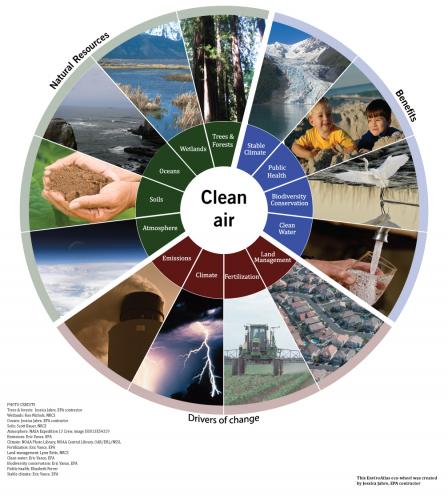EnviroAtlas Benefit Category: Clean Air
Ecosystems produce clean air
- The natural production and maintenance of clean air is important for overall human health and well-being.
- The earth around us naturally provides clean air that is produced from a series of complex interactions between the land and atmosphere. Forests, for example, absorb carbon dioxide and produce oxygen.
- To help produce clean air, natural resources such as wetlands, trees, and soil, filter many pollutants from our air. Some of these pollutants include carbon monoxide (CO), ozone (O3), particulate matter (PM), and nitrogen oxides (NOx).
- The ability of an ecosystem
 ecosystemAll living things and nonliving things in an area, as well as the interactions between them. to filter pollutants from the air varies by region, topography, season/climate, ecosystem type, ecosystem fragmentation or connectivity, and the species composition of that system.
ecosystemAll living things and nonliving things in an area, as well as the interactions between them. to filter pollutants from the air varies by region, topography, season/climate, ecosystem type, ecosystem fragmentation or connectivity, and the species composition of that system. - Local weather and topography affect how air pollutants may disperse, and certain types of trees, such as conifers and deciduous broadleaf species, are particularly efficient at pollutant removal.
Air quality stressors and drivers of change
- Multiple factors detract from clean air, including natural factors and human activities.
 This eco-wheel image shows the natural resources providing clean air, the benefits, and drivers of change.Natural factors can include wildfires, extreme weather events, and volcanic emissions.
This eco-wheel image shows the natural resources providing clean air, the benefits, and drivers of change.Natural factors can include wildfires, extreme weather events, and volcanic emissions.- Air pollution created by human activities, such as certain land management practices, crop fertilization, and vehicular and industrial emissions, are also drivers of change in regards to air quality.
- Land management affects traffic patterns and the amount of green space in an area, which can contribute to the presence or lack of vegetation that removes certain air pollutants. Land management can also affect vehicle miles traveled (VMTs), increasing vehicular emissions of air pollutants such as NOx and CO2.
- Mobile sources are by far the largest emitters of four of the six criteria air pollutants that are regulated by the U.S. EPA under the National Ambient Air Quality Standards
 National Ambient Air Quality StandardsNational Ambient Air Quality Standards are federal standards for the minimum ambient air quality needed to protect public health and welfare. They have been set for six criteria pollutants: sulfur dioxide (S02), particulates (PM/PM10), nitrogen oxides (NOX), carbon monoxide (CO), ozone (O3), volatile organic compounds (VOC), and lead (Pb).1. Chemical reactions in the atmosphere can produce secondary pollutants such as ground level ozone.
National Ambient Air Quality StandardsNational Ambient Air Quality Standards are federal standards for the minimum ambient air quality needed to protect public health and welfare. They have been set for six criteria pollutants: sulfur dioxide (S02), particulates (PM/PM10), nitrogen oxides (NOX), carbon monoxide (CO), ozone (O3), volatile organic compounds (VOC), and lead (Pb).1. Chemical reactions in the atmosphere can produce secondary pollutants such as ground level ozone. - Dust particles from agricultural practices, as well as SO2 emissions from electricity generation, are also major air pollution sources.
- Fertilizing crops with nitrogen-rich materials like animal manure can also affect air quality and climate stabilization, by returning potent greenhouse gases (GHGs
 GHGsGases in the Earth's atmosphere that produce the greenhouse effect. Changes in the concentration of certain greenhouse gases, due to human activity such as fossil fuel burning, increase the risk of global climate change. Greenhouse gases include water vapor, carbon dioxide, methane, nitrous oxide, halogenated fluorocarbons, ozone, perfluorinated carbons, and hydro fluorocarbons.) such as methane, NOx, CO2, and gaseous ammonia back to the atmosphere.
GHGsGases in the Earth's atmosphere that produce the greenhouse effect. Changes in the concentration of certain greenhouse gases, due to human activity such as fossil fuel burning, increase the risk of global climate change. Greenhouse gases include water vapor, carbon dioxide, methane, nitrous oxide, halogenated fluorocarbons, ozone, perfluorinated carbons, and hydro fluorocarbons.) such as methane, NOx, CO2, and gaseous ammonia back to the atmosphere.
Health impacts and benefits
- Even at low concentrations, air pollutants such as ozone and PM can trigger a variety of health problems such as asthma attacks, coughing, and lung irritation, as well as increase susceptibility to longer term illnesses such as cardiovascular diseases2.
- The ability of natural resources to remove air pollutants from the atmosphere reduces their negative effects and improves public health.
- Airborne fine particles (PM2.5) are the main cause of reduced visibility (haze) in parts of the United States, impacting the quality of outdoor experiences in U.S. national parks and wilderness areas. The natural removal of these particles from the atmosphere can improve visibility and increase our ability to enjoy these outdoor spaces.
- Cleaner air means fewer pollutants that can redeposit onto land and water bodies, resulting in improved water quality, and lower concentrations of GHGs that trap heat and reduce climate stability.
- For more information on the health benefits of clean air, explore the Clean Air portion of the Eco-Health Relationship Browser.
References
- EPA. National Emission Inventory. 2008. Emission Source Sectors. Accessed January 2013.
- EPA. Criteria Air Pollutants. Accessed February 2019.
